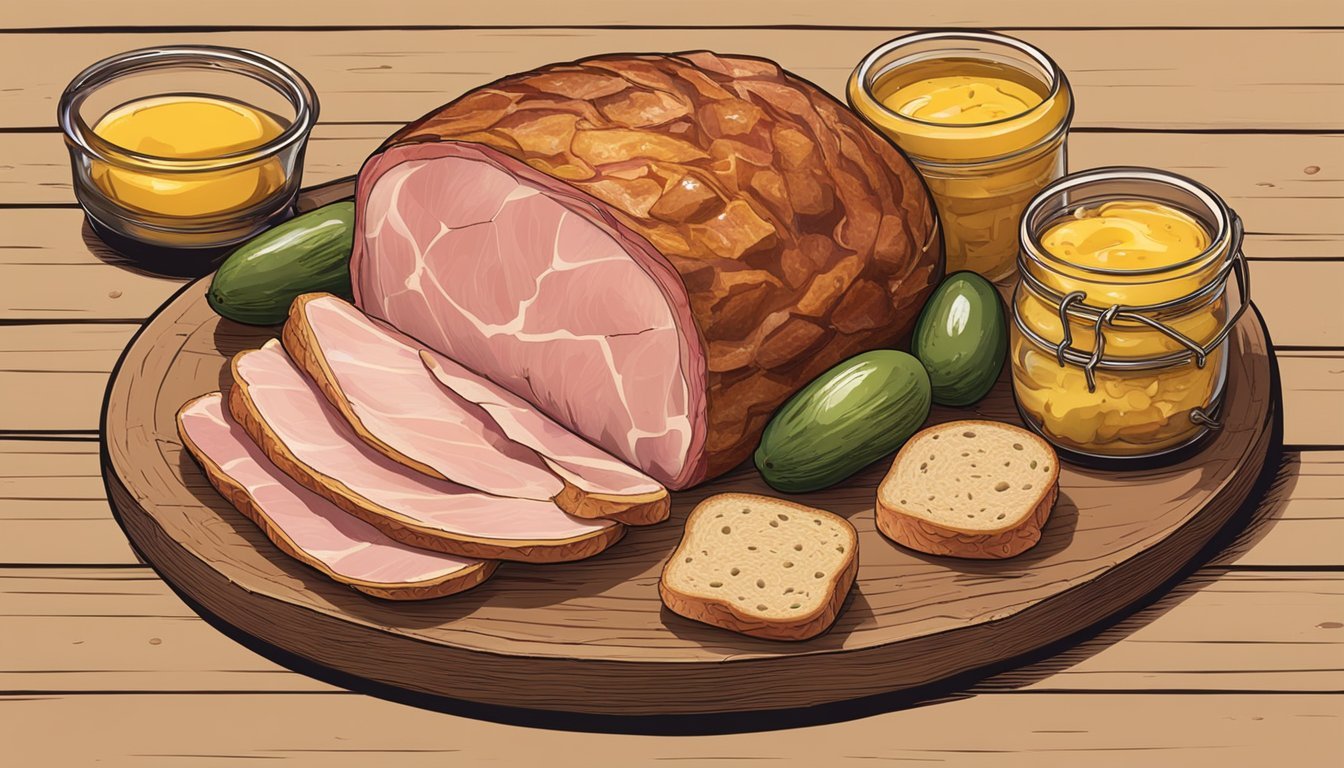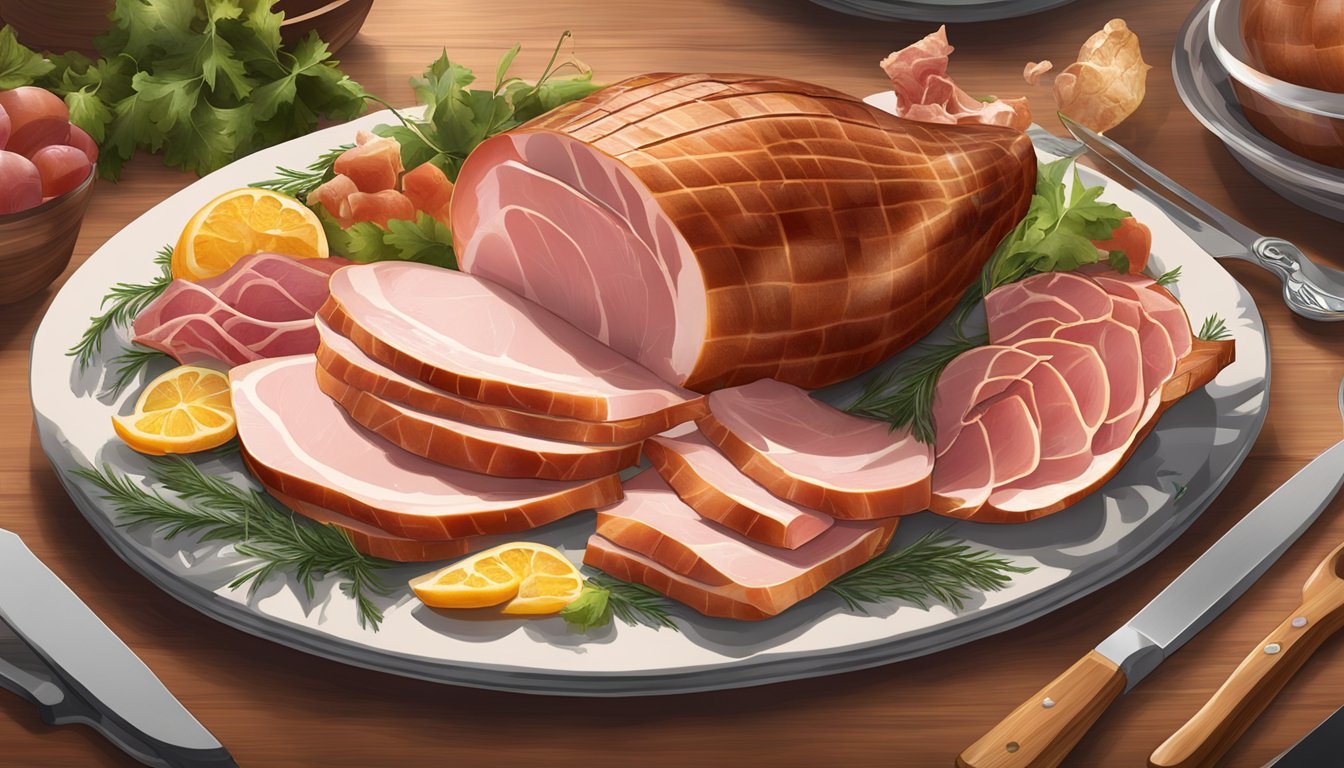Smoked Ham Preparation
The Ultimate Guide for Juicy, Flavorful Meat
Smoked ham is a culinary delight that represents the epitome of savory comfort food, enjoyed by people across different cultures and culinary traditions. It is a meat product often derived from the leg cut of pork, which is then preserved through the ancient practice of smoking. This process not only imparts a rich, distinctive flavor to the meat but also extends its shelf life, making it a staple in festive feasts and everyday meals alike.
The art of smoking a ham involves curing the meat, either with a dry rub or a wet brine, followed by the application of smoke from various wood types such as hickory, applewood, or cherry. The wood choice plays a critical role in defining the ham's final flavor profile. The ham is then typically smoked at a low temperature over several hours, allowing the smoky aroma to thoroughly permeate the meat, resulting in a succulent and tender end product.
While traditional methods of smoking ham might be time-consuming, contemporary cooking techniques have made it more accessible for home cooks. With the advent of pellet grills, ceramic, electric, or pellet smokers, creating a sumptuous smoked ham at home has become a relatively simple process that yields delicious results, particularly when coupled with a glaze of brown sugar, honey, or maple, providing an enticing balance of sweet and smoky flavors. (What wine goes well with smoky flavors?)
Basics of Smoking Ham
Smoking ham infuses it with rich, smoky flavors and succulence that oven-cooking cannot replicate. Mastery of this technique hinges on the selection of the ham and a clear understanding of the smoking process, including the right equipment, wood choice, and temperature control.
Choosing the Right Ham
The ideal candidate for smoking is a pre-cooked ham, as this variety has already been cured and cooked, requiring only reheating and flavor enhancement through the smoking process. Should one choose to smoke a fresh ham, it means starting from scratch — curing and cooking — which significantly extends the cook time. The size of the ham will determine the cooking time, typically ranging between 1 1/2 to 4 hours.
Understanding the Smoking Process
Firstly, one needs to secure a reliable smoker that can maintain a consistent temperature. The type of wood used for smoking can vary; popular options include hickory, oak, cherry, apple, and pecan, each imparting its distinct flavor profile to the ham.
The smoking temperature is critical and should be held steady, usually at around 275°F. A pre-cooked ham is smoked until it reaches an internal temperature of about 140°F to 145°F. Using a meat thermometer is advisable to accurately monitor the ham's internal temperature throughout.
By following these basics, one ensures the smoked ham reaches the desired doneness infused with a perfect balance of smokiness.
Preparation Techniques
Proper preparation is crucial for enhancing the flavor and texture of smoked ham. The two main techniques are brining and curing, followed by applying a carefully crafted rub or glaze.
Brining and Curing
Diving into the world of ham preparation, let's chat about the cozy process of brining and curing. Picture this: your ham is taking a leisurely swim in a spa-like solution of water and salt, getting all cozy with a touch of sweetness from sugar or brown sugar. And hey, why not throw in some personality with optional spices, herbs, or a cheeky splash of bourbon? It's all about locking in that moisture and giving the taste a little kick.
Now, let's switch gears to curing, where things get a bit drier but no less exciting. Imagine coating your ham with a dry mix of salt, sugar, and those all-important curing agents like nitrates. It's like a dry marinade that works its magic to pull out moisture and amp up that hammy goodness. This flavor-intensifying vacation can last from a quick getaway to a long retreat, depending on how grand your ham is.
Applying the Rub and Glaze
Moving on to the makeover phase—applying the rub and glaze. Once your ham has had its brine or cure time, it's ready to get dressed up with a rub. Think of a sweet coat of brown sugar, a sprinkle of ground spices for that oomph, and a dash of herbs for a whiff of the garden. It's all about building those layers of flavor.
And for the grand finale, the amazing glaze! It's the shiny coat that makes your ham irresistible, blending the natural sweetness of honey with more brown sugar for that sticky, caramelized charm. Add a dollop of mustard or a splash of vinegar for a zing, and why not a bit more complexity with fruit juices or bourbon?
As you lovingly spread the glaze over the ham, you're setting the stage for that rich, caramelized crust that just beckons you to take a bite. It's a casual affair, but one that promises a mouthwatering journey from start to finish.
Cooking and Serving
Before indulging in the savory delight of smoked ham, proper cooking and serving techniques are vital to ensure optimal flavor and safety. Paying close attention to internal temperature and proper carving will elevate the ham from a simple cut to the centerpiece of a meal.
Smoking the Ham
To smoke a bone-in ham so it can truly shine as the main course, one must maintain a balance between heat and time. The smoker should be preheated to a stable temperature, generally around 325°F. As for the internal temperature, one should aim for between 140°F and 145°F in the thickest part of the ham, away from the bone. Utilizing a digital thermometer or a meat thermometer is crucial for monitoring this internal temperature throughout the smoking process.
Resting and Carving
Once the ham reaches the ideal internal temperature, it should rest before carving. This allows the juices to redistribute, resulting in a more moist and flavorful meat. Resting should typically last for 15 to 20 minutes. When it's time to carve, one should place the ham on a stable cutting board or platter and use a sharp knife to cut thin slices against the grain.
The carved ham can then be arranged on a platter and served alongside a variety of side dishes that complement its rich flavor. Popular choices often include roasted vegetables, (What wine goes well with roasted vegetables?) mashed potatoes, or a fresh salad. Leftover ham offers versatility and can be repurposed into sandwiches or added to dishes such as ham and bean soup.
Advanced Techniques and Variations
This section explores refined smoking methods and innovative recipes to enhance the classic smoked ham.
Using Different Woods
The choice of wood is crucial as it imparts distinctive flavors to the smoked ham. For a deep, traditional taste, hickory is a reliable option, offering a strong flavor profile that complements the savory nature of ham. Apple wood provides a sweeter, fruitier note, well-suited for those preferring a milder smoke essence. Mesquite, with its intense, earthy flavor, is best used sparingly, as it might overpower the meat if not balanced correctly. An experienced smoker might experiment with mixing different woods to create a unique flavor signature. For optimal control and consistent quality, one can use a pellet smoker, such as a Traeger, which allows for precise smoking temperatures and a steady supply of smoke.
Specialty Recipes
Innovative recipes push the boundaries of the conventional smoked ham. A twice smoked ham amplifies the smokiness and allows for the addition of a glaze or rub between the rounds of smoking. This technique can be particularly appealing with a spiral cut ham as the glaze seeps into deeper layers for a more intense flavor.
If you're craving that smoky goodness in your ham but want to keep it simple, your Instant Pot has got your back. It won't give you that old-school smoked vibe, but it's a champ at making your ham tender in a jiffy. And here's a fun tip: after pressure cooking, give your ham a quick stint in a smoker or brush on a smoky finishing glaze to get that smokiness you're after.
Now, let's talk wood chips because they're like the secret sauce for that additional wood-fired flavor. If you're going for a strong, traditional smoky taste, hickory is your go-to wood. It's like the burly lumberjack of the wood chip world, perfect for those hearty smoked meats that make your heart sing. But maybe you're in the mood for something a little sweeter and fruitier? Apple wood chips have got you covered, giving a gentle nudge of smokiness that's just right for when you want a milder touch.
And for those times when you're feeling a bit bold and want an intense, earthy flavor, mesquite is the way to go. It's like the espresso of wood chips—best for short smoking sessions so it doesn't overpower your senses.
Playing around with these wood chip flavors and mixing up your techniques can turn your smoked ham from just okay to a show-stopping, taste bud-tingling masterpiece.
Smoked Ham Recipe
Alright, let's dive into the delicious world of smoked ham with a recipe that's sure to get you started with your journey of smoking meats or just looking to smoke a ham for the weekends. This recipe ensures that the smoke flavor is evenly distributed throughout the ham and is paired with a homemade glaze packed with flavor.
Ingredients:
1 pre-cooked bone-in ham (about 8-10 pounds)
1 cup brown sugar
1/4 cup honey
2 tablespoons Dijon mustard
1/4 cup apple cider vinegar
1 teaspoon ground cinnamon
1/2 teaspoon ground cloves
1/2 teaspoon ground ginger
1/4 teaspoon ground nutmeg (how long does nutmeg last?)
Wood chips (applewood or hickory work great)
Instructions:
Prep the Ham: Remove your ham from the packaging and let it sit at room temperature for about an hour before smoking. This helps the meat cook evenly.
Preheat Your Smoker: Fire up your smoker to 275°F. While it's heating up, soak your wood chips in water for about 30 minutes to prevent them from burning up too quickly.
Create the Glaze: In a medium bowl, mix together the glaze ingredients consisting of brown sugar, honey, Dijon mustard, apple cider vinegar, cinnamon, cloves, ginger, and nutmeg until it forms a thick paste.
Score the Ham: Using a sharp knife, score the surface of the ham in a diamond pattern. This allows the glaze to penetrate deeper into the meat.
Apply the Glaze: Generously brush the glaze over the entire ham, making sure to get it into the scored lines.
Smoke the Ham: Place the ham in the smoker and add your wood chips to the smoker box while closely monitoring the quality of smoke (blue smoke) produced. Close the lid and smoke the ham until it reaches an internal temperature of 140°F to 145°F. This should take about 1 1/2 to 2 hours, depending on the size of your ham. Remember to replenish the wood chips as needed.
Rest the Ham: Once the ham has reached the desired internal temperature, transfer it to a cutting board and let it rest for 15 to 20 minutes. This helps the juices redistribute for a more succulent ham.
Carve and Serve: Slice the ham against the grain and serve it up with your favorite sides. Think roasted Brussels sprouts, a creamy potato bake, or a vibrant green salad.
A Slab of Hearty Flavor
A smoked ham recipe that's sure to impress with its perfect balance of sweet and smoky flavors. The beauty of this recipe is that you can tweak the glaze to your liking or try different wood chips to infuse new flavors. Remember, the key to a great smoked ham is patience and love, so take your time and enjoy the process.




